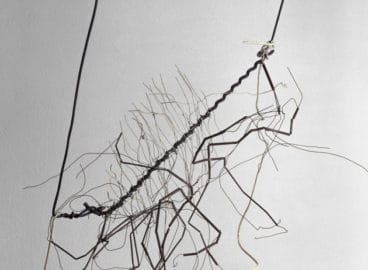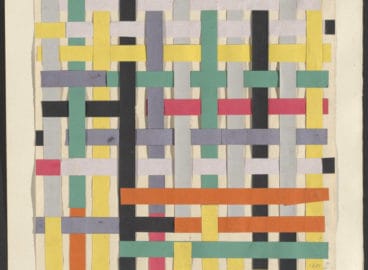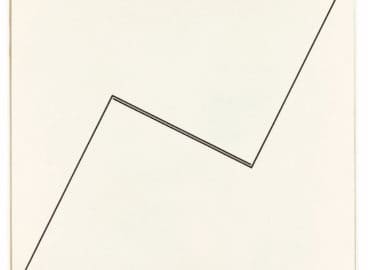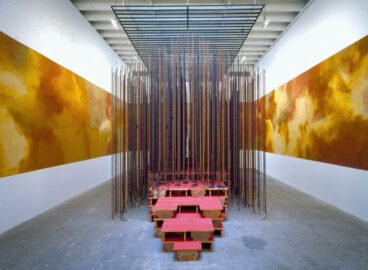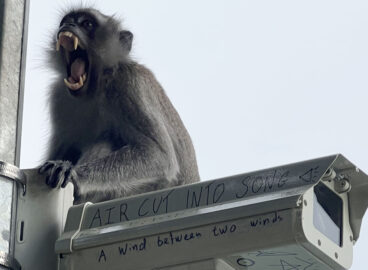In late 2016 and early 2017, a team from The Museum of Modern Art’s C-MAP Asia Group traveled to India and Sri Lanka. We asked the participants to contribute a brief text based on one (or more) of their activities on the trip – a studio, exhibition, or film festival visit, an artwork or architectural site, among other things. After following the work of Gauri Gill for many years and meeting with her in New Delhi, curator Sarah Suzuki acquired two works from Gill’s Fields of Sight series (in collaboration with Rajesh Vangad) for The Museum of Modern Art’s collection. Here she discusses the works’ collaborative making and the complex negotiation between craft and contemporary art.

While the arenas of contemporary art and traditional practice can sometimes seem starkly disconnected, an exploration of cultural and aesthetic traditions is one fruitful lens through which artists have considered and addressed current conditions. Often this is achieved through a re-investigation of methods, materials, and motifs. While these forms are sometimes identified with a historical place and time, and are no longer practiced, others continue to be viable and relevant today, though often situated within the realm of craft, vernacular culture, or folklore, rather than of high culture or the avant-garde.
In a recent series of materially and formally hybrid collaborations, called Fields of Sight, the artists Gauri Gill and Rajesh Vangad suggest the proximity and productive tension of the traditional and the contemporary, as they mix visual languages, artistic strategies, and global concerns in new and surprising ways. The Delhi-based photographer Gauri Gill has become a strong voice in the international contemporary art community over the last few years, with gallery exhibitions and major photography prizes, as well as group shows at the Philadelphia Museum of Art, Yale University Art Gallery, the Whitechapel Gallery, and the Smithsonian’s Freer Gallery and Arthur M. Sackler Gallery in Washington, D.C. Since 1999 Gill has embedded herself in nomadic Rajasthani communities, documenting the everyday lives, traditions, and struggles of their citizens, often revisiting the same subjects over an extended period of time in a continuous process of documentation, as in the ongoing series Notes from the Desert.
Her collaborator for Fields of Sight, Rajesh Vangad, comes from a very different segment of India’s art world—he practices the traditional tribal folk form known as Warli. Vangad has recently been awarded major commissions in Mumbai, at the Consulate General of Switzerland, and the Chhatrapati Shivaji International Airport. His work is in the collections of the National Crafts Museum in Delhi and the Queensland Art Gallery/Gallery of Modern Art. He is a third-generation practitioner of Warli, an art form that dates back to 3000 BCE and is his matrilineal legacy. Warli painting relies heavily on a geometric vocabulary of circles, triangles, and squares, inventively combined to suggest human and animal forms engaged in the activities of daily life, of harvest, and of other yearly rituals, but as Vangad says, “Art thrives when it expands,” and his distinctive style includes contemporary motifs and images.

Fields of Sight, comprising Gill’s black-and-white photographs, dizzyingly overdrawn with Vangad’s dancing Warli forms, resulted from a series of long conversations between the artists, with Vangad sharing the history, legends, and folklore of his hometown of Ganjad, which has a complex history of change and unrest. The pictures speak to both artists’ interpretations of the physical and spiritual landscape, and of the city’s past, present, and future. Vangad appears in each image, not only as an artist, but also as a narrator, suggesting that he is spinning stories that fill the pictographic space. The pair of pictures seen here suggests an urban-rural continuum, a breakneck rate of change and growth, the centrality of ecological concerns. Perhaps an unlikely pairing—a contemporary photographer obsessed with documenting communities that live almost beyond the reach of the present, and a traditional artist bringing an ancient form into the modern moment—Gill and Vangad have produced a thought-provoking body of work that asks the viewer to expand his or her own field of sight.
